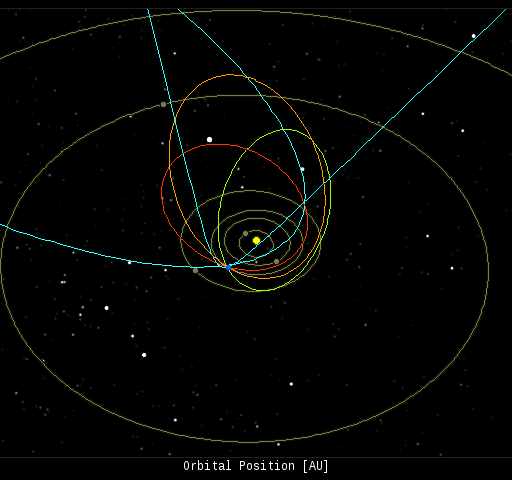|
Did you miss the lunar eclipse? No problem. The Coca-Cola Science Center recorded it for you. Click here to play the movie.
|
|
|
IS LIGHTNING A FORM OF SPACE WEATHER? A new study published in the May 15th edition of Environmental Research Letters finds that lightning rates over Europe are modulated by the solar wind. The results contradict some previous studies, and the physical mechanism linking lightning and solar wind is uncertain. Nevertheless, the research appears credible and worthy of follow-up with global studies beyond Europe. Read the full report. Solar wind alerts: text, voice
EXTREMOPHILES BLASTED BY COSMIC RADIATION: On May 10th, the students of Earth to Sky Calculus flew four colonies of halobacteria to the stratosphere, setting a high-altitude ballooning record for this species of microbe. During the two and a half hour flight, they ascended to 111,000 feet. Radiation data from an X-ray/gamma-ray sensor on the payload have just been analyzed and, suffice it to say, the microbes had a blast:

The halobacteria were hit by ionizing radiation 28 times stronger than at ground level, similar to what they might experience on the planet Mars. It might seem counterintuitive that the radiation peak did not occur at the apex of the flight. Instead, the extremophiles absorbed their greatest dose about half way up. This peak at ~60,000 feet is the "Pfotzer Maximum," named after physicist George Pfotzer who discovered it using balloons and Geiger tubes in the 1930s.
When cosmic rays crash into Earth's atmosphere, they produce a spray of secondary particles. With increasing depth in the atmosphere, primary cosmic rays decrease as the secondary particles increase. This complex situation results in a maximum dose rate in the tropopause, not the overlying stratosphere. .
The students have been flying halobacteria through the Pfotzer Maximum to explore the possibility that terrestrial extremophiles could survive in places like Mars. The answers are growing inside an incubator in the students' AP Biology classroom. Stay tuned for updates from the Petri dish.
Realtime Space Weather Photo Gallery
PINK PLANET AT SUNSET: The Pink Planet is back. After an absence of more than 3 months, Mercury is emerging from the glare of the sun and making itself visible again in the evening sky. Giuseppe Petricca sends this picture taken last night in the Peligna Valley of central Italy,

"We had a wonderful sunset with beautiful twilight colors," says Petricca. "In the middle of my photographic session I remembered that Mercury would be visible, and indeed it was. It was the only bright dot shining through the twilight."
Mercury is mostly gray, not pink, but many observers perceive it as pink because of the surrounding rosy glow of sunset. Look west at sunset. What color do you see?
The view will improve in the evenings ahead. Mercury is heading for its best apparition of 2014 on May 25th when it willl be a full 23 degrees from the sun. Keep an eye on the sunset--and Mercury; it's a nice way to end the day.
Realtime Space Weather Photo Gallery
Realtime Aurora Photo Gallery
Realtime Mars Photo Gallery
Realtime Comet Photo Gallery
Every night, a network of NASA all-sky cameras scans the skies above the United States for meteoritic fireballs. Automated software maintained by NASA's Meteoroid Environment Office calculates their orbits, velocity, penetration depth in Earth's atmosphere and many other characteristics. Daily results are presented here on Spaceweather.com.
On May. 13, 2014, the network reported 7 fireballs.
(5 sporadics, 1 eta Lyrid, 1 eta Aquariid)

In this diagram of the inner solar system, all of the fireball orbits intersect at a single point--Earth. The orbits are color-coded by velocity, from slow (red) to fast (blue). [Larger image] [movies]
Potentially Hazardous Asteroids (
PHAs) are space rocks larger than approximately 100m that can come closer to Earth than 0.05 AU. None of the known PHAs is on a collision course with our planet, although astronomers are finding
new ones all the time.
On May 17, 2014 there were 1475 potentially hazardous asteroids.
Notes: LD means "Lunar Distance." 1 LD = 384,401 km, the distance between Earth and the Moon. 1 LD also equals 0.00256 AU. MAG is the visual magnitude of the asteroid on the date of closest approach.
| |
The official U.S. government space weather bureau |
| |
The first place to look for information about sundogs, pillars, rainbows and related phenomena. |
| |
Researchers call it a "Hubble for the sun." SDO is the most advanced solar observatory ever. |
| |
3D views of the sun from NASA's Solar and Terrestrial Relations Observatory |
| |
Realtime and archival images of the Sun from SOHO. |
| |
from the NOAA Space Environment Center |
| |
the underlying science of space weather |